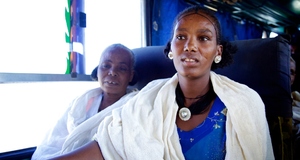The Modern and the Traditional: African Women and Colonial Morality
By
2017, Vol. 9 No. 10 | pg. 1/2 | »
IN THIS ARTICLE
KEYWORDS
IntroductionModernity and tradition are used as contradictory and exclusive concepts where the former indicates progress and the latter indicates a past without contemporary legitimacy. Modernity characteristically denotes a post-traditional, post-medieval historical period, one marked by the transition from feudalism and agrarian structure to capitalism, industrialization, secularization, rationalization, the nation-state and its institutions with their systems of surveillance (Barker 2005, 444). Conceptually, however, modernity refers to the modern era. For a while in the eighteenth century, culture was used as equivalent of civilization in a sense established by Enlightenment historians. The “natives” were perceived to not have culture at all. Then that notion was challenged by anthropologists and the word “culture” was used as an alternative to express other kinds of human development and variable cultures of different peoples in different periods of time. Civilization was used in Europe to express the triumph of modernity where the modern world recognized itself as better than antiquity. At the time, Europe came at encounter with other cultures it continued to describe itself as civilized and modern but in contrast not only to antiquity but to other cultures as well. Thus, Europe created the concept of savageness and barbarism as antithesis to its modernity and civilization. Henceforth, Europe was to represent the modern model and the rest was to represent the antiquity; the traditional. Accordingly, the modern model, that is Europe, embarked on missions of civilizing and modernizing the traditional; that is the rest of the world in which Africa is “the most traditional;” the most backward.These labels continued to exist where the modern remained the modern and the traditional remained the traditional in a curious way despite the shifts and changes that happened on the meaning and signs of modernity. In this essay, I would like to address this observation by asking: what is the modern and what is the traditional, how are they identified, by whom, when and according to what premises? I address this broad question by examining one cultural component: women and sexual morality. I choose this topic in particular because women's sexual morality is often connected to freedom and progress whether in religious, political, or cultural theories. In modernity, women's liberation and empowerment is a major theme where women’s rights are used as a measure of progress. To grasp these issues I focus on male-female relationships, dress, and dance to examine cultural themes. In the first section I will examine women's morality in Europe to understand the moral ground on which Europe perceived and judged women in Africa. In the second section I choose dress as an interesting topic that signals people's belief systems and morality. In the third section I examine dance as a cultural feature that indicates the cultural values and moral views of its society. In the conclusion, I discuss the observed patterns of modernity according to which the traditional is defined. I cite examples across time and geographies to discuss contours of the notion of modernity. Women and Morality in Colonial EuropeIt is known that colonialism was declared as a civilizing mission in which political forces joined religious missionaries to bring the light of progress to the “dark continent.” The civilizing mission targeted both the moral and material conditions of its subjects. Civilizing the subjects morally was to introduce the European values to the African people. During colonialism, introducing “European values” meant specifically introducing European bourgeois values as it has been indicated by many scholars when tracing the formation of theories of race. According to some scholars, racial theories were embedded in the making of class identity in European societies. Foucault, for instance, explains the economic processes and political structure in which the decline of absolutism and monarchy and the rise of liberalism, commitment to “freedom” and modernity undermined social hierarchies based on descend and called for new ways of naturalizing the inequities on which the emergent bourgeois order was based. According to many scholars, including Foucault and Stoler, sexuality was a major moral issue and measure of class identity. Foucault, for instance, suggests that earliest technologies of sex arose around the eighteenth century around the political economy of population, regulating the modes of sexual conduct by which populations could be expanded and controlled. Sex, according to Foucault and others, was the tool for surveillance of individual’s morality where the bourgeois were considered the most virtuous class whiles the poor lacked morality. Accordingly, modernity, was a process in which the older codes of legitimacy were replaced by a system of power in which individual’s sexuality was scrutinized and controlled to maintain class identity and population control. Although scholars debate the processes and the dates of developing theories and practices of race, it is agreed that in the eighteenth century it became the codes of colonial order in which modernity, the civilizing mission, and the “measure of man” were formed. For instance, Stoler argues that the assertion, of bourgeois order and morality was never distinct from the changing definition of who was European; cultural appropriateness and sexual practices secured racial identities(Stoler,1996). Hence, we could argue that racism and the control over individual’s sexuality were necessarily linked to “modernity” as identified by European colonial powers. The individual’s sexual practices signaled her level of morality and granted her the respectability required by modernity if these practices showed restrain and control. This notion was projected on colonial subjects to signify their level of need of modernity. For example, as Stoler, in Race and the Education of Desire, points out that the discursive management of the sexual practices of colonizer and colonized was fundamental to the colonial order of things. She elaborates that “the discourses of sexuality at once classified colonial subjects into distinct human kinds while policing the domestic recesses of imperial rule”(Stoler,1996:4). This indicates that sexual practices signaled “others' ” level of morality and classified them accordingly on the ladder of civilization on which Europeans were on the top. If colonial Europe considered itself modern, that is sexually virtuous and “appropriate,” others would be immoral sexual beings and Africans were the most eroticized and described as promiscuous and shameless. The focus on sexuality guided bourgeois morality in Europe was directed squarely towards women where their bodies were politicized and moralized. They were considered the bearers of more racist imperial order. For example, the Dutch and English women were not allowed to emigrate because it was feared that they would bring “shame to the nation” and disgrace to all Christian nations if they bedded with non-White men(Stoler,1996). Thus men’s sexual anxiety was not only about their own desire but also about controlling women’s sexuality. We notice that this obsession with sexuality had different motivations during colonial era. In the seventeenth century it was motivated by the notion of “Christian nation” in which it was a matter of religious teaching to repress and scandalize sexuality. And in the nineteenth century it was motivated by the notion of bourgeois respectability. Nonetheless, the indicated obsession by women’s sexuality was a shared feature in both bourgeois and Christian notions. It is needless to say that this control over women sexuality could not possibly be only about sex without other gender-based implications such as lack of social independence and inferior cultural status. This point is important to mention because it indicates the meaning of “liberating” African women claimed by colonial agents and their civilizing mission as will be discussed later. Therefore, in colonial discourses, sexuality, women, and the way they dressed or behaved were heavily addressed in describing the savageness of the subjects or/and in forging the ways of “civilizing” them. For instance, in The Races of Europe, William Z. Ripley argues that “one of the most subtle physiological effects of a tropical climate is a surexcitation of sexual organs, which in the presence of a native servile morally underdeveloped population often leads to excesses even at a tender age” (emphasis is mine) (Young,1995 :150). Also In History of Jamaica, Edward Long states “African women are libidinous and shameless as monkeys, or baboons…in fact they admit these animals frequently to their embrace”(Young,1995 :150-151). Obviously, such descriptions were primarily informed by and rooted in religious morality where codes of ethics were outlined by Christian teachings as Richard wrote in 1940 Richard that “Christian sex ethic was to many Africans the chief content of Christian teachings, since it is by largely keeping or failing to keep the Christian sex codes that the convert wins or loses membership of the church”(Chanock,1998:155). Accordingly, colonial agents made it their task to halt practices of the past and bring modernity which was directed squarely towards controlling African women and their sexuality. Women and Sexual Morality in AfricaIn “Law Custom and Social Order: The Colonial Experience in Malawi and Zimbabwe,” Chanock indicates that white people, during colonialism, severely condemned Africans sexual morality and women status; they were considered to have no sexual morals at all. For example, Lomwe people of central Africa were described: “their morality so low adultery was not considered an offense.” It was also reported about the women of the Mang’anja: “the chastity of women or their feelings on the subject (if they have any) is not considered; it is their customs to occasionally change wives.” Also, Fort Johnson reported that “between the Mvera and Monkey bay no man dare trust his wife.” Smith and Dale also wrote about the Ilan “how fragile the marriage bond is… women are bandied from man to man; and of their own accord leave one husband to another. It is not unusual a woman scarcely out of her teens to have had four or five husbands still living.” Also, Reverend Guillaime observed of the Bemba “for the smallest reason woman quitted her husband’s house.” Additionally, officials in Northern Rhodesian government were concerned that “parents allowed their daughters far greater freedom.” So the white man’s mission appeared to be both the “liberation” of women and the “improvement of morals.” (Chanock, 1996: 145-159). Accordingly, one of the ways by which African marriage and sex practices were addressed was to give men more control over women’s sexuality. This view was, of course, informed, as mentioned before, by bourgeois morality and commitment to modernity. For instance, in 1907 Judge Griffin in Malawi states in evaluating the effects of colonial policies introduced on marriage laws and practices that “a native looks upon all infractions of his marriage contract ..as serious wrong which he is quick to resent and punish, and I am strongly of the opinion that every assistance should be given for the maintenance of the security of his domestic rights.” Also, as a measure of control over women’s sexuality, the colonial court did not acknowledge any case brought without “evidence of legal marriage” according to Christian rules. Those bonds which did not submit to marriage were considered “immoral connection” and any redress made by court is “to uphold immorality.” African unions, in the eyes of colonial agents, “declined the morals of women” because of the the freedom it allowed to them. Furthermore, the Northern Rhodesian courts, to forge a law against the “frivolous girls” they worked on controlling their sexual behavior by giving much authority to the “controllers of the society” referring to “headmen and the young men” (Chanock, 1996). Thus, improving women morality according to colonial modernity was pursued by introducing a patriarchal structure where men seized power over women’s sexuality. Colonialism addressed African women's morality also through their gender roles. Domesticity was promoted as a method of “civilizing” women. Traditionally, African women worked in the field cultivating crops and processed diaries. Missionaries trained and supervised the “Jeanes” teachers- females home demonstrators. They were funded by colonial state during 1930s through 1970s- to train Zimbabwean women around the country on “modernizing” concepts of domesticity (Hendricksson, 1996). It is needless to explain that these values according to contemporary measures are diametrically opposed not only to values upheld by current notions of “modernity” but also to the common sense of individual’s rights and women’s rights. What to underscore here is that what was perceived by colonial powers as immoral, backward, savage, and traditional among Africans was actually what the West came to declare as modernity, progress and women empowerment centuries later. This is evident in the celebration of the sexual revolution of the sixties of the twentieth century in the West and touting it as a decade of sexual revolution, women liberation, and progressive social movements. Many Marxists, for instance, analyzed the sexual revolution of the sixties as revolution against bourgeois identity which was forged centuries earlier around the confinement of sexuality. The anti-authoritarian and rebellious movements of the 1960s considered the reproductive suburban family and its morality of self-restraint and moral puritanism as a manifestation of class domination. Henceforth, sexual liberation, was tied to revolutionary accomplishments. These accomplishments were the change in the relationships between women and men, mainly those stirred by the emerging women’s liberation movements. This led to females’ increased presence in the public domains and personal independence concerning reproductive choices and sexual expression. Wasn't that the freedom made colonialists call African women shameless and urged colonialists' modernity to introduce patriarchal structure to restrain them? Wasn’t that the public presence of African women colonial modernity fought in its civilizing mission by enforcing “domesticity”? It is interesting to observe that the goals Europeans set to “modernize” African women were the confinements and backwardness the revolutionaries of the sixties set to overcome. The modern progressive practices accomplished in 1960s were the practices colonial powers fought in Africa and perceived as features of savageness and immorality. This leads us to construe that the “modern” and “civilized” promoted in Africa was nothing but the opposite of what colonial powers’ cultural values and moral views were. The “modern” and “civilized” was not about an objective meaning; it was about passion and sentiment and not about rationality as modernity is claimed to be absolutely about. ClothingAnother area on which African women’s morality was addressed and controlled was the way they dressed. The colonial conquest created sociopolitical systems in which African people were forced to convert to Christianity and to wear Western styles of dress. Clothing “the natives” was a central focus of the colonial missionary project. In Africa, in Bechuanaland, a frontier region between colonial Botswana and South Africa, the process of moralization required dressing Africans in European clothes “to cover their nakedness” and control their bodies through new hygiene methods. Missionaries were pleased when Africans submitted to European clothing, seeing it as a sign of religious conversion in the new moral system of soul and body. Additionally, colonial agents often sent a message by dressing in full European outfit and touring in Africa; they wanted to dress “properly” to be viewed as evidence of Europeans’ moral and cultural superiority (Fashion and Clothing Encyclopedia). This practice was indeed informed by the racist views which guided colonialism. Philip Setel, for example, has argued that nineteenth century travel narratives about Africa define “a conceptual domain in which health, illness and techniques of bodily display linked Africans to preconceived notions of race, moral status and savagery” (emphasis is mine)(Hendrickson, 1996: 193). That is to say colonial agents saw the revealing Africans' outfits and interpret them as signs of Africans’ low morality. So the statement colonial agents were making by touring in Africa in European outfits was intended to “ inspire” Africans to embrace “modernity” embodied in European covering clothing thereby, hopefully, elevate them in the ladder of morality. Interestingly, “clothing the natives” was a task delivered in a number of formulas one of which is “hygiene” besides morality and respectability. But the fact that this task was tackled mainly by missionaries indicates its religio-moral motivation for which sexuality is a measure of propriety. In Zimbabwe, for example, the strong emphasis on hygienic training was led by missionaries where they pursued the making of Christian “civilized” African communities. Changes in appearance and habits of converts, particularly the wearing of European dress became essential symbol of what the missionaries wished to be a full socio-moral transformation of African life. Yet, it is important to notice that it was not merely sexuality; it was rather women’s sexuality. For example, in Clothing and Difference, Burke states that African women were the most exaggerated subjects to promote “civilized” manners. In many ways, she points out, “the imagined body of the colonial subject in Zimbabwe was first black but also crucially female…Zimbabwean women in both rural and urban communities were increasingly exposed to settler notions about…bodily propriety” (Hendrickson, 1996:195). The excessive focus on African women’s sexuality reflects the compromised social status of European women which projected its opposite on the African women, thereby labeling it “backward.” That is, European women and sexuality was controlled by men in a patriarchal structure and Christian worldview which scandalized sexuality and scrutinized individuals with more emphasis on women’s “body propriety” and demanded them to dress in all-covering outfits. Therefore, the dressing habits of African women signaled the opposite of the “civilized” European moral system and habits therefore, received the title ‘traditional” and “backward.” Accordingly, the campaigns carried out by colonial powers to improve women’s morality and civilize them manifested, among other things, in the way they dressed. In Clothing and Difference James traces the substantial changes on clothing in South Africa over three generations, he states that little girls were “supposed to wear blouses to cover breasts.” He also identifies the main features of clothing introduced by colonialism as: length of dress, headscarf with large piece of cloth and bangle, vest, knit shirt, overalls and a piece of cloth wrapped around the waist. In the same text, Moning analyzes the relation between identity and clothing; he describes the impact of Europeans on the Pedi of Sekhuneland’s dress. He states that “ most initiated girls nowadays wear long, gaily-colored cloths from their loin down to their feet covering the traditional clothing while very few women wear traditional hair-style, usually covering their heads with a head-cloth instead”(Hendrickson, 1996:39). Moning explains that if people adopt these Western clothes, “they are seen as treading one way path from tradition to modernity” (Hendrickson, 1996:39). It is obvious from the description of clothing above, specially the headscarf and the length of the dress, it was intended to fight the display of the revealed bodies of African women and to “improve their morality” according to colonial notions of modernity. This feature of modernity, as perceived by colonial powers, is not only diametrically opposite but also antagonistic to the contemporary notions of modernity and progress especially regarding gender, sexuality and women liberation. That is especially true when we realize, for example, the recent uproar against females’ headscarf in France. The members of French judicial system aver that the law advocates France's value of secular liberalism, basically what makes France "French," and many perceive females' headscarf, not as a religious and cultural belief but as resistance to modernity. It is interesting to note that this is the same headscarf, along with the lengthy dress and overalls, introduced a century earlier by colonialism as “modernizing” and civilizing” feature and to “improve African women’s morality.” This is a striking irony between two diagrammatically opposite features of modernity regarding women liberation in colonial context in Africa and in Western context in regards to the headscarf. It is important to briefly note here the fact that in both cases women’s right to choice has been fundamentally compromised in a way mocks modernity’s most celebrated ideals: freedom and individualism. Moreover, some advocates of headscarf prohibition claim that it diminishes the boundaries between the public and the private. Scott for instance argues “the head scarf is tangible sign of intolerable difference.... It stands for everything that is thought to be wrong with Islam: porous boundaries between public and private and between politics and religion; the supposed degradation of female sexuality and subordination of women" (Najmabadi, 2006). Interestingly, this was the same boundary colonial modernity completely removed when it instructed African women about how to dress to be moral and civilized. It was also the same boundary the British destroyed when they made marriage and women-men relationships a public matter by forging laws that condemn any practice in Africans’ private lives that was not approved by the court and the church. It was also the same subordination of women in Africa by colonialists through introducing a patriarchal system in which men were assigned guardians of women’s sexuality and custodians of females’ morality. In addition, when missionaries joined forces with colonialism to introduce these modernizing features it had already canceled the religion-politics boundary. It was all about the differences that colonialism refused to tolerate and opted for corrosively altering their subjects’ cultures, just as Scott now refuses to tolerate the “headscarf difference” in the statement above. All carried out in the name of modernity and civilization. Another domain which colonial modernity addressed regarding morality and women’s bodies was dance. Here I would like to extend the discussion about dress to dance where I highlight the concepts of women’s body and nudity in relation to dance and modernity.Continued on Next Page » Suggested Reading from Inquiries Journal
Inquiries Journal provides undergraduate and graduate students around the world a platform for the wide dissemination of academic work over a range of core disciplines. Representing the work of students from hundreds of institutions around the globe, Inquiries Journal's large database of academic articles is completely free. Learn more | Blog | Submit Latest in Anthropology |


















